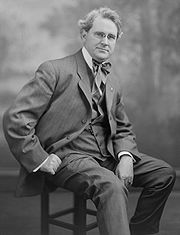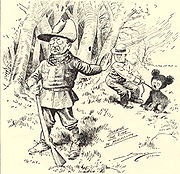
Clifford K. Berryman
Encyclopedia


Washington Star
The Washington Star, previously known as the Washington Star-News and the Washington Evening Star, was a daily afternoon newspaper published in Washington, D.C. between 1852 and 1981. For most of that time, it was the city's newspaper of record, and the longtime home to columnist Mary McGrory and...
newspaper from 1907-1949. He was also a cartoonist for The Washington Post
The Washington Post
The Washington Post is Washington, D.C.'s largest newspaper and its oldest still-existing paper, founded in 1877. Located in the capital of the United States, The Post has a particular emphasis on national politics. D.C., Maryland, and Virginia editions are printed for daily circulation...
from 1891-1907.
Berryman was born on April 2, 1869 in Clifton, Kentucky to James Thomas Berryman and Sallie Church Berryman. He married Kate Geddes Durfee in July, 1893, and they had three children: Mary Belle (died as an infant), Florence Seville (an art critic) and James Thomas (a Pulitzer-Prize winning cartoonist). Berryman was an active member of the Washington Heights Presbyterian Church. He was the first cartoonist member of the Gridiron Club
Gridiron Club
The Gridiron Club and Foundation, founded in 1885, is the oldest and one of the most prestigious journalistic organizations in Washington, D.C. Its 65 active members represent major newspapers, news services, news magazines and broadcast networks. Membership is by invitation only and has...
and served as the president in 1926.
Berryman died December 11, 1949 from a heart ailment and is buried in Glenwood Cemetery.
Editorial cartoons
Berryman's father, James, often entertained friends and neighbors with drawings of "hillbillies" from their hometown. Clifford inherited his father's knack for drawing and was appointed draftsman to the United States Patent Office in Washington, D.C. from 1886-1891. During his tenure, Berryman submitted sketches to The Washington Post, and in 1891, he became an understudy of the Posts political cartoonist, George Y. Coffin. After Coffin died in 1896, Berryman took the Post cartoonist position until 1907, at which time he was hired by the Washington Star. He continued to draw political cartoons for the Star until this death in 1949.During his career, Berryman drew thousands of cartoons commenting on American Presidents and politics. Presidential figures included former Presidents Theodore Roosevelt
Theodore Roosevelt
Theodore "Teddy" Roosevelt was the 26th President of the United States . He is noted for his exuberant personality, range of interests and achievements, and his leadership of the Progressive Movement, as well as his "cowboy" persona and robust masculinity...
, Franklin D. Roosevelt
Franklin D. Roosevelt
Franklin Delano Roosevelt , also known by his initials, FDR, was the 32nd President of the United States and a central figure in world events during the mid-20th century, leading the United States during a time of worldwide economic crisis and world war...
and Harry S. Truman
Harry S. Truman
Harry S. Truman was the 33rd President of the United States . As President Franklin D. Roosevelt's third vice president and the 34th Vice President of the United States , he succeeded to the presidency on April 12, 1945, when President Roosevelt died less than three months after beginning his...
. The cartoons satirized both Democrats and Republics and covered topics such as drought, farm relief and food prices; representation of the District of Columbia in Congress; labor strikes and legislation; campaigning and elections; political patronage; European coronations; the America's Cup; and the atomic bomb.
Berryman was a prominent figure in Washington, D.C., and President Harry S. Truman once told him, "You are ageless and timeless. Presidents, senators and even Supreme Court justices come and go, but the Monument and Berryman stand." Berryman's cartoons can be found at the Library of Congress, National Archives and George Washington University, as well as archives that house presidential collections.
The teddy bear
In his November 6, 1902 Washington Post cartoon, "Drawing the Line in Mississippi," Berryman depicted President Theodore RooseveltTheodore Roosevelt
Theodore "Teddy" Roosevelt was the 26th President of the United States . He is noted for his exuberant personality, range of interests and achievements, and his leadership of the Progressive Movement, as well as his "cowboy" persona and robust masculinity...
showing compassion for a small bear cub. The cartoon inspired New York store owner Morris Michtom
Morris Michtom
Morris Michtom was a Russian Jewish immigrant, who with his wife Rose invented the Teddy Bear.Mitchtom, who arrived in New York in 1887, was selling candy in his shop at 404 Tompkins Avenue in Bedford-Stuyvesant Brooklyn by day and making stuffed animals with his wife Rose at night. The Teddy Bear...
to create a new toy and call it the teddy bear
Teddy bear
The teddy bear is a stuffed toy bear. They are usually stuffed with soft, white cotton and have smooth and soft fur. It is an enduring form of a stuffed animal in many countries, often serving the purpose of entertaining children. In recent times, some teddy bears have become collector's items...
.
Awards
In 1944, Berryman was awarded the Pulitzer Prize for Editorial CartooningPulitzer Prize for Editorial Cartooning
The Pulitzer Prize for Editorial Cartooning has been awarded since 1922 for a distinguished cartoon or portfolio of cartoons published during the year, characterized by originality, editorial effectiveness, quality of drawing, and pictorial effect...
for his drawing "Where is the Boat Going." The cartoon depicted President Franklin D. Roosevelt and other government officials trying the steer the USS Mississippi in several different directions.

